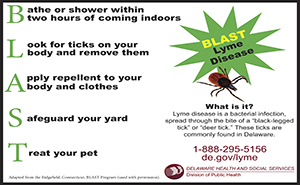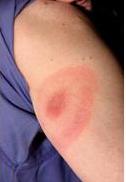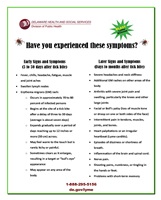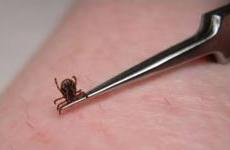Blue Spots From Lyme Disease Hurtful or Not

History

Lyme disease is the most common vector-borne disease in the United States with approximately 20,000 new cases reported each year.
Lyme disease gets its name from a small coastal town in Connecticut called Lyme. In 1975, a woman brought an unusual cluster of pediatric arthritis cases to the attention of Yale researchers. In 1977, the Yale researchers identified and named the clusters "Lyme arthritis." In 1979, the name was changed to "Lyme disease," when additional symptoms such as neurological problems and severe fatigue were linked to the disease. In 1982 the cause of the disease was discovered by Dr. Willy Burgdorfer. Dr. Burgdorfer published a paper on the infectious agent of Lyme disease and earned the right to have his name placed on the Lyme disease spirochete now known as Borrelia burgdorferi.
Lyme Disease Awareness Information:
- For Patients
- For Providers
The CDC offers the following https://www.cdc.gov/lyme/healthcare/index.html. A free, CDC-sponsored Clinician Outreach and Communication Activity (COCA) course helps providers learn to properly identify and treat tick-borne diseases (CME/CNE/CECH available): Little Bite, Big Disease: Recognizing and Managing Tickborne Illnesses.
New at CDC! Rocky Mountain Spotted Fever Toolkit & Free Continuing Education: https://www.cdc.gov/rmsf/resources/toolkit.html
Statistics
Delaware is among the top 10 states with the highest incidence rates in the United States. Follow these links below to view Delaware-specific maps of Lyme cases and statistics.
- Delaware-specific map of 2018 Lyme Cases
- Delaware-specific map of 2017 Lyme Cases
- Delaware-specific map of 2016 Lyme Cases
- Delaware-specific map of 2015 Lyme Cases
- CDC Lyme disease statistics
LYME DISEASE IN DELAWARE
| YEAR | STATEWIDE TOTAL NUMBER OF CASES (Confirmed and Probable cases) | NEW CASTLE COUNTY | KENT COUNTY | SUSSEX COUNTY | STATEWIDE INCIDENCE RATE (Cases/100,000 based on population data from the US Census Bureau) |
|---|---|---|---|---|---|
| 2020 | 353 | 249 | 43 | 161 | 36 |
| 2019 | 659 | 437 | 86 | 136 | 67 |
| 2018 | 520 | 302 | 87 | 131 | 53.8 |
| 2017 | 608 | 338 | 119 | 151 | 64 |
| 2016 | 506 | 295 | 92 | 119 | 53.2 |
| 2015 | 436 | 286 | 75 | 75 | 46.1 |
| 2014 | 417 | 262 | 92 | 63 | 44.6 |
| 2013 | 509 | 301 | 91 | 117 | 55 |
| 2012 | 670 | 338 | 132 | 137 | 73.1 |
| 2011 | 877 | 561 | 149 | 167 | 96.6 |
| 2010 | 658 | 409 | 147 | 102 | 73.3 |
| 2009 | 984 | 622 | 195 | 167 | 110.3 |
| 2008 | 768 | 518 | 141 | 109 | 86.9 |
| 2007 | 713 | 453 | 165 | 95 | 81.8 |
| 2006 | 478 | 209 | 118 | 70 | 55.8 |
| 2005 | 614 | 337 | 166 | 111 | 72.7 |
Transmission
The Lyme disease bacterium, Borrelia burgdorferi, is transmitted to animals and humans through the bite of an infected blacklegged or deer tick. Immature ticks are very tiny and can be difficult to see which can increase the possibility of undetected tick exposures. Ticks (including species other than the blacklegged or deer tick) can also transmit diseases other than Lyme disease, including Rocky Mountain spotted fever, ehrlichiosis and anaplasmosis.
There is no evidence that Lyme disease is transmitted from person-to-person. For example, a person cannot get infected from touching, kissing or having sex with a person who has Lyme disease. Humans most often acquire Lyme disease in the spring and summer months when they enjoy outdoor activities.

Symptoms
The Lyme disease bacterium can infect several parts of the body which can cause different symptoms at different times. Symptoms of Lyme disease can be nonspecific and may resemble other diseases. If you think you have Lyme disease it is important that you contact your healthcare provider. Follow this link for a printable poster of common symptoms.

Early Symptoms:
- Rash – Lyme disease is frequently characterized by an expanding red rash, commonly referred to as a bull's - eye rash. Rashes can occur anywhere on the body, and vary in size and shape. The rash can be warm to the touch, but usually not painful or itchy. Not all patients will develop the characteristic rash.
- Fever and/or chills
- Fatigue
- Muscle and joint aches
- Headache
Untreated infections can lead to a variety of symptoms, some of which can be very serious and debilitating. These symptoms can include:
- Severe joint pain and swelling (usually large joints, particularly the knees)
- Loss of muscle tone on one or both sides of the face (called, "Bell's palsy")
- Heart palpitations and dizziness
- Severe headaches and neck stiffness due to meningitis
- Neurological problems (i.e., numbness or tingling in the hands or feet, problems with concentration and short term memory)
DiagnosisDiagnosis is based on symptoms, physical findings (i.e., bull's – eye rash, facial palsy or arthritis) and a history of possible exposure to ticks. Validated laboratory tests are available to assist the clinician with the diagnosis. Laboratory testing is not recommended or necessary when a patient develops the characteristic bulls-eye rash. Lyme disease can be difficult to diagnose. Not all patients with Lyme disease will develop the characteristic bulls-eye rash and tick exposures often go undetected. |  For Medical Professionals: |
Treatment
Most cases of Lyme disease can be cured with a few weeks of antibiotics taken by mouth. Depending on symptoms, some patients may require a second course of antibiotic therapy. Patients with certain neurological or cardiac forms of illness may require intravenous (IV) antibiotics.
A small percentage of patients with Lyme disease have symptoms that last months to years after treatment with antibiotics. These symptoms can include muscle and joint pains, arthritis, cognitive defects, sleep disturbance, and fatigue. The cause of these symptoms is not known. There is some evidence that they result from an autoimmune response, in which a person's immune system continues to respond even after the infection has been cleared.
Surveillance and Reporting
The Centers for Disease Control and Prevention (CDC) initiated Lyme disease surveillance in the United States in 1982. Lyme disease became a reportable condition in Delaware in 1989 under the Regulations for the Control of Communicable and other Disease Conditions which made Lyme disease, as well as many other diseases and conditions, reportable to the Bureau of Epidemiology in Delaware Division of Public Health (DPH).
In turn, DPH submits weekly data regarding all reportable diseases to CDC. CDC is then able to publish weekly reports and annual summaries in the Morbidity and Mortality Weekly Report (MMWR). The data in the weekly MMWR are provisional, based on weekly reports to CDC by state health departments.
For surveillance purposes, a case of Lyme disease in Delaware is defined according to the CDC/Council of State and Territorial Epidemiologists (CSTE) case definition.
The Bureau of Epidemiology in DPH utilizes Delaware Electronic Reporting and Surveillance System (DERSS) to automatically receive positive laboratory results from major commercial laboratories on all reportable diseases, including Lyme disease. Additionally, all acute care hospitals in Delaware submit reportable disease reports electronically into DERSS.
Delaware is one of the few states that is dedicated to investigating each and every possible case of Lyme disease reported to the Bureau of Epidemiology. Because of the high incidence of Lyme disease in Delaware and the difficulty with diagnosis, it is important to maintain a high level of surveillance for the disease. This level of surveillance is labor intense for the epidemiologists as well as time consuming for the medical providers who are asked to complete case report forms. Epidemiologists send case report forms to ordering medical providers on each case to gather additional data. This data assists epidemiologists to determine which cases can be confirmed in accordance with the CDC/CSTE case definition.
PREVENTION IS KEY!
Personal protection:
- Know where to expect ticks -- blacklegged ticks live in moist and humid environments, particularly in or near wooded or grassy areas. You may come in contact with ticks during outdoor activities around your home or when walking through vegetation such as leaf litter or shrubs.
- Wear light colored clothing to allow you to see ticks crawling on your clothing.
- When possible, wear long sleeves and long pants. Tuck your pant legs into your socks so that ticks cannot crawl up inside of your pant legs.
- Apply tick repellants. Repellents containing permethrin can be sprayed on boots and clothing and will last for several days. Repellents containing DEET can be applied to the skin but will last only a few hours before reapplication is necessary. Use insect repellent containing less than 50 percent DEET for adults. Use repellent containing less than 30 percent DEET on children. The American Academy of Pediatrics (AAP) Committee on Environmental Health updated their recommendation for use of DEET products on children in 2003, citing: "Insect repellents containing DEET (N,N-diethyl-m-toluamide, also known as N,N-diethyl-3-methylbenzamide) with a concentration of 10 percent appear to be as safe as products with a concentration of 30 percent when used according to the directions on the product labels." AAP recommends that repellents with DEET should not be used on infants less than 2 months old.
- Upon return from outdoor activities in potentially tick-infested areas, search your body for ticks. Take special care to check under the arms, in and around the ears, inside the belly button, behind the knees, between the legs, in and around all head and body hair and around the waist.
- Check children for ticks, especially in the hair. Additionally, ticks may be carried into the household on clothing and pets.

Tick Removal:
- Use fine-tipped tweezers or shield your fingers with a tissue, paper towel or rubber gloves. Avoid removing ticks with bare hands whenever possible.
- Grasp the tick close to the skin surface and pull upward with steady, even pressure.
- Do not squeeze, crush, or puncture the body of the tick since its fluids (saliva, body fluids, gut contents) may contain infectious germs.
- After removing the tick, cleanse the site with an antiseptic or soap and water, and wash your hands.
- The use of home remedies such as petroleum jelly or hot matches for tick removal are not recommended. These methods do not work.
- View/print our "Blast Lyme Disease" poster
Landscape Management:
- Keep grass mowed.
- Remove leaf litter, brush and tall weeds from around the home and the edge of your lawn.
- Use plantings that do not attract deer or exclude deer through various types of fencing. Deer are the main food source for adult ticks.
- Move firewood, birdhouses and feeders away from the home.
- Create a 3-foot or wider wood chip, mulch or gravel barrier between your lawn and woods.
- Modify your landscaping to create "tick-safe zones ".
To learn more about Lyme Disease:
- DPH Lyme Disease Fact Sheets
- Learn About Lyme Disease
- Control Ticks Around Your Home and in Your Community
- Lyme Disease Resources on the Internet
- Infectious Disease Society of America (IDSA) - Treatment Guidelines
- MMWR - Notice to Readers: Caution Regarding Testing for Lyme Disease
- MMWR - Lyme Disease, United States 2003-2005
- American Lyme Disease Foundation
Return to Epidemiology Home Page
![]() Please note: Some of the files available on this page are in Adobe PDF format which requires Adobe Acrobat Reader. A free copy of Adobe Acrobat Reader can be downloaded directly from Adobe . If you are using an assistive technology unable to read Adobe PDF, please either view the corresponding text only version (if available) or visit Adobe's Accessibility Tools page.
Please note: Some of the files available on this page are in Adobe PDF format which requires Adobe Acrobat Reader. A free copy of Adobe Acrobat Reader can be downloaded directly from Adobe . If you are using an assistive technology unable to read Adobe PDF, please either view the corresponding text only version (if available) or visit Adobe's Accessibility Tools page.
Source: https://dhss.delaware.gov/dph/epi/lyme.html
0 Response to "Blue Spots From Lyme Disease Hurtful or Not"
Post a Comment